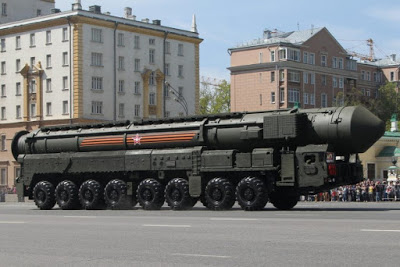Some Russian arms do not fall under New START treaty
Russian and U.S. diplomats are discussing numerous issues for the prolongation of the Strategic Arms Reduction Treaty (New START). The inclusion of new Russian strategic deterrence is considered. The Izvestia daily writes about the development stage of the weapons and which of them Russia can drop without detriment to the national security.
Follow Army Recognition on Google News at this link

RS-28 Sarmat heavy intercontinental ballistic missile (ICBM) is an ambitious and long-awaited project (Picture source: Wikimedia)
In March 2018, Russian President Vladimir Putin announced several new weapons in the state-of-the-nation address. They have to give Russian a potential in the foreseeable future to guarantee the national security. The START negotiations are discussing hypersonic Kinzhal and Tsirkon missiles, heavy RS-28 Sarmat, intercontinental missile with Avangard gliding reentry vehicle, Peresvet laser, Poseidon underwater unmanned craft, and nuclear-powered Burevestnik cruise missile.
Kinzhal can be considered a nuclear weapon carrier. Its missile has much in common with air ballistic 9M723 missile of Iskander-M tactical launcher which can carry a nuclear warhead. However, the system of strategic offensive arms cannot consider it strategic, as it does not have an intercontinental range.
Traditionally, the START treaty included long-range bombers with cruise missiles. MiG-31K aircraft that carries Kinzhal is in no way a heavy bomber. Kinzhal has a high destruction precision and does need a nuclear warhead. There is no reliable information about its nuclear capabilities so far. Kinzhal has been deployed at least in one airbase in Akhtubinsk. There are plans to deploy it in the Arctic and the Far East. It is possible to consider Kinzhal in the total Russian nuclear force, but it is likely to remain outside the START treaty.
RS-28 Sarmat heavy intercontinental ballistic missile (ICBM) is an ambitious and long-awaited project. It is to replace Voevoda and become the most important segment of the nuclear missile potential. The missile underwent pop-up trials and is preparing for flight trials which are likely to take the whole of 2021. The deployment of the new ICBM is expected in late 2021.
In the START framework, Sarmat is to be included anyway, as it replaces Voevoda which is already included. It is possible that Sarmat, like Voevoda, will carry only ten reentry vehicles although the payload can be 1.5 times bigger. Therefore, treaty provisions will not affect Sarmat in any way.
Intercontinental Avangard with a hypersonic reentry vehicle has been accepted into service and its deployment began in 2019 in Orenburg division of the Strategic Missile Forces. Twelve launchers with UR-100NUTTKh missiles have to go on combat duty by 2027. As Avangard is a strategic nuclear weapon, it will be included in START, however the deployment plans are unlikely to be affected.
The Pentagon has admitted that the U.S. defense program against hypersonic weapons is poorly developed and leaves much to be desired. Nothing is known about Russian successes in this sphere. Gazeta.ru writes about technical problems of the fight against hypersonic cruise missiles.
U.S. Defense Advanced Research Projects Agency (DARPA) said the gliding unit designed by the Tactical Boost Glide (TBG) program can potentially develop a speed of Mach 20.
In March 2020, the US Ground forces and the Navy successfully held the first flight trials of a hypersonic gliding vehicle which developed a hypersonic speed and hit the target in the assigned place. The vehicle can potentially develop a maximum speed of Mach 17.
Mach 17-20 means 5.6-6.6 km-sec. There are no antiaircraft missiles capable of intercepting such targets. To down them, it is necessary to have a new quality of radar reconnaissance. The Americans plan to deploy sensors in the near space for that.
Completely different antiaircraft guided missiles with maneuverable engines are necessary to intercept hypersonic cruise missiles in the thin layers of the atmosphere. The cost of the antimissile will inevitably grow.
There is another important issue. Such speeds rule out humans from operation. The whole process from detection, tracking to antimissile launch should be automatic. However, such interception is possible in case of equable and straight movement of the target. If the missile maneuvers in altitude and course, it is impossible to down it in general, as guidance becomes extremely difficult. The antimissile needs a homing warhead and artificial intelligence.
Another major problem is a huge price gap between the attack and defense weapons. Let us imagine that an effective system has been deployed against hypersonic cruise missiles to defend an important political center or top command post. It should have the necessary radars in launch positions, computers and stocks of guided antimissiles.
The system will be several times more expensive that an aircraft with hypersonic cruise missiles and will not guarantee effective protection against a massive strike with hypersonic missiles. A country will have to spend the whole national budget to deal with the problem. The same price gap concerns defense against prospective drones.
The opinion that hypersonic missiles are more effective than any aerospace attack weapon is definitely correct. No effective interception systems are likely in the foreseeable future that will meet the minimal cost-efficiency ratio. A country which succeeds to be the first to arm its forces with hypersonic missiles will be able to fulfil any operational and strategic mission, Gazeta.ru said.
© Copyright 2020 TASS / Army Recognition Group SPRL. All rights reserved. This material may not be published, broadcast, rewritten or redistributed.




























